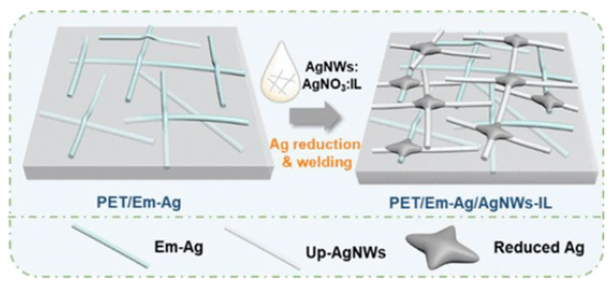Realizing 17.5% Efficiency Flexible Organic Solar Cells via AtomicLevel Chemical Welding of Silver Nanowire Electrodes
Guang Zeng1,#, Weijie Chen1,#, Xiaobin Chen1, Yin Hu1, Yang Chen1, Ben Zhang1, Haiyang Chen1, Weiwei Sun1, Yunxiu Shen1, Yaowen Li1,*(李耀文), Feng Yan1, and Yongfang Li1,2
1 Laboratory of Advanced Optoelectronic Materials, Suzhou Key Laboratory of Novel SemiconductorOptoelectronics Materials and Devices, College of Chemistry, Chemical Engineering and Materials Science and State and Local Joint Engineering Laboratory for Novel Functional Polymeric Materials, Jiangsu Key Laboratory of Advanced Functional Polymer Design and Application, Soochow University, Suzhou 215123, P. R. China
2 Beijing National Laboratory for Molecular Sciences, CAS Key Laboratory of Organic Solids, Institute of Chemistry, Chinese Academy of Sciences, Beijing 100190, P. R. China
# G.Z. and W.C. contributed equally to this work.
J. Am. Chem. Soc. 2022, 144, 8658--8668
Solution processable flexible transparent electrodes (FTEs) are urgently needed to boost the efficiency and mechanical stability of flexible organic solar cells (OSCs) on a large scale. However, how to balance the optoelectronic properties and meanwhile achieve robust mechanical behavior of FTEs is still a huge challenge. Silver nanowire (AgNW) electrodes, exhibiting easily tuned optoelectronic/mechanical properties, are attracting considerable attention, but their poor contacts at the junction site of the AgNWs increase the sheet resistance and reduce mechanical stability. In this study, an ionic liquid (IL)-type reducing agent containing Cl– and a dihydroxyl group was employed to control the reduction process of silver (Ag) in AgNW-based FTEs precisely. The Cl– in the IL regulates the Ag+ concentration through the formation and dissolution of AgCl, whereas the dihydroxyl group slowly reduces the released Ag+ to form metal Ag. The reduced Ag grew in situ at the junction site of the AgNWs in a twin-crystal growth mode, facilitating an atomic-level contact between the AgNWs and the reduced Ag. This enforced atomic-level contact decreased the sheet resistance, and enhanced the mechanical stability of the FTEs. As a result, the single-junction flexible OSCs based on this chemically welded FTE achieved record power conversion efficiencies of 17.52% (active area: 0.062 cm2) and 15.82% (active area: 1.0 cm2). These flexible devices also displayed robust bending and peeling durability even under extreme test conditions.

链接://pubs.acs.org/doi/10.1021/jacs.2c01503